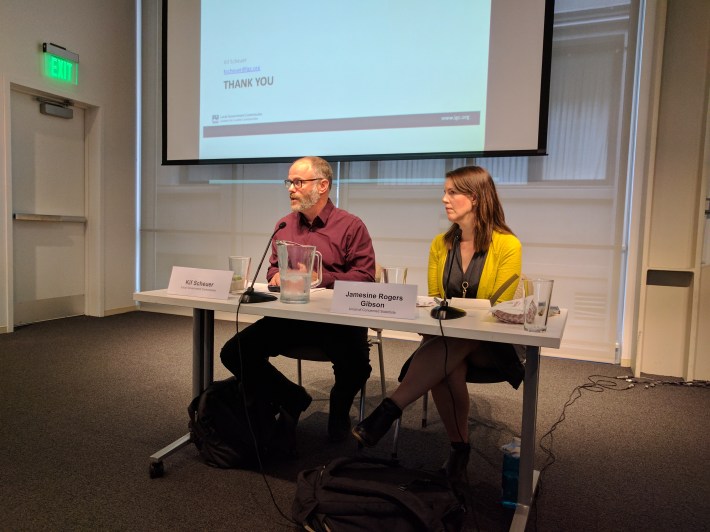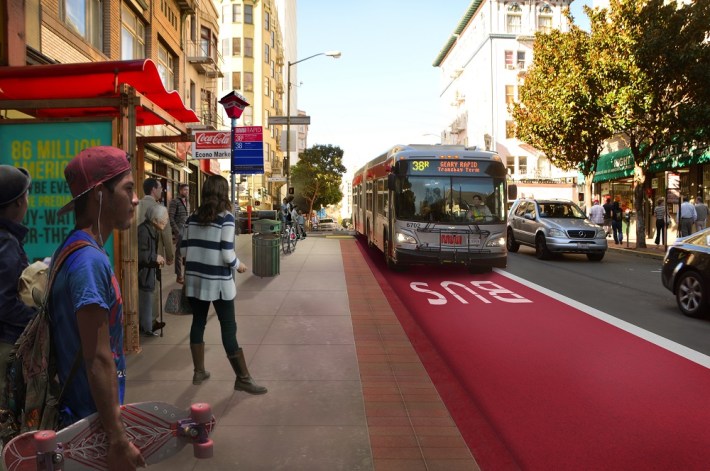To be a successful transportation planner, you've also got to be a persuasive salesman. "The thing about transportation is whether you drive, take a train, or bike, everyone has an opinion on it," said David Latterman of Fall Line Analytics at a presentation on public outreach and transportation held today at SPUR's San Francisco location. "And that’s a scary thing, because everyone has to tell you their opinion." It means that transportation planners need to get buy-in on their projects from a huge pool of people to keep them from being delayed, watered down, or worse.
That also means transportation planners have to start polling, doing outreach, and generally selling their project long before the first shovel hits the ground--or even before the first blueprints and renderings get drawn up. "You can’t start this too soon," said Latterman, adding that the outreach process has to be treated just like a political campaign.
Latterman cited Geary Bus Rapid Transit as an example of a project that planners failed to sell. "The baseline of public support was there," he said, "but it was never used correctly. Positive leverage could have been really useful."
Early on, he said, planners should have been out talking to people who ride the bus. They needed to find out what riders like about dedicated "red carpet" bus lanes, and what they want to see improved. Instead, the project was delayed for at least a decade. "Naysayers were a small [but] vocal minority--merchants and a few others," said Latterman, but the failure to build and quantify support meant that "the politicians just listened to the loudest voices."
Katie DeLeuw of the public outreach firm EnviroIssues said research is key. "You need to identify your audience ... know the languages they speak, how people communicate, what they care about. What are their values? What will resonate with them?"

"Treat it like a political endeavor, with talking points," said Latterman. Talking points can be used as anchors for discussing what people like--and don't like--about a project.
But it is also important, as the project progresses, to inform the public about what was done with their feedback. So if someone requests a modification, say the preservation of a parking spot, the city needs to get in touch with that person and tell them whether it was preserved and if not, what was done to either replace that parking spot, or why it was impossible to do so. "Don’t ask for input and then do stuff in a black box. You have to tell people that you heard them ... and report back to the community," said DeLeuw.
"The important thing is to make sure it’s genuine," she said.
It's also key, she said, to show how projects relate to something tangible. She mentioned an example from Seattle, where her firm sold a freight project by showing how it played into the distribution system for a popular local treat. "We showed how your fish and chips get to you ... the cod, the malt vinegar, have to get all the way to the brewery in Seattle where you eat your fish and chips." Ultimately their efforts helped get buy-in for an update to the city's freight master plan.
She cautioned planners to "leave room for flexibility, because things always change. If you plan a big community meeting and only three or four people show up, you may need to rethink [whether] community meetings are the right tool."

For the Geary Bus Rapid Transit project, that could have meant riding the bus and speaking to the community of bus riders, in Chinese, Spanish, and in English, said Latterman. It meant relating the project to them getting home faster. Planners needed to build lists of supporters. "Engage the public and get them to do the work for you," said Latterman.
Why didn't that happen? According to Latterman, sometimes the problem comes down to the planners themselves, who don't always want to listen to the public. "They say 'I went to MIT, I know what I’m doing.' Yeah, but they [the public] don’t care. I try to convince planners that sales is part of your job, and if it isn’t you better hire people to go do it for you."
For more events like these, visit SPUR’s events page.





